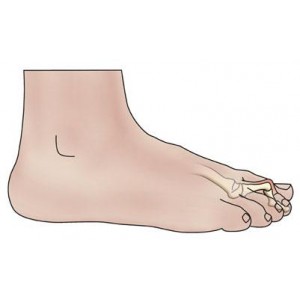Crooked Toes
Crooked Toes: Crooked toes can appear in several forms and include overlapping, hammer, claw and mallet toes. These ailments can be unsightly, uncomfortable and painful.
Overlapping toes are characterized by one toe lying on top of an adjacent toe. The reddened areas on either side of this foot illustration show what overlapping toes might look like. Hammer, mallet and claw toes occur when ligaments and tendons in the toe tighten and cause the toe joints to stay bent. These conditions typically occur in the smaller toes and can affect one or all of these four toes on a foot. Depending on the severity of the condition, the deformed toes can remain flexible or become rigid. A flexible toe will remain bent but will straighten when pressure is applied to the buckled area but a rigid toe will not straighten at all. A hammer toe affects the first two joints of the toe, causing the toe to bend and raise the second knuckle upward. A mallet toe affects the last joint at the end of the toe, causing the knuckle closest to the toenail to bend and point the toe tip downward. A claw toe looks like a combination of a hammer toe and a mallet toe. It affects all three joints of the toe, causing the second knuckle to bend upward and the last knuckle to curl underneath it with the toe tip pointing downward.
Symptoms:
Causes:
Treatment:Severely crooked toes, particularly those that are rigid, may require surgery. However, the progression of the condition for toes that are flexible can sometimes be slowed, and surgerymay be able to be postponed, by:
Overlapping toes are characterized by one toe lying on top of an adjacent toe. The reddened areas on either side of this foot illustration show what overlapping toes might look like. Hammer, mallet and claw toes occur when ligaments and tendons in the toe tighten and cause the toe joints to stay bent. These conditions typically occur in the smaller toes and can affect one or all of these four toes on a foot. Depending on the severity of the condition, the deformed toes can remain flexible or become rigid. A flexible toe will remain bent but will straighten when pressure is applied to the buckled area but a rigid toe will not straighten at all. A hammer toe affects the first two joints of the toe, causing the toe to bend and raise the second knuckle upward. A mallet toe affects the last joint at the end of the toe, causing the knuckle closest to the toenail to bend and point the toe tip downward. A claw toe looks like a combination of a hammer toe and a mallet toe. It affects all three joints of the toe, causing the second knuckle to bend upward and the last knuckle to curl underneath it with the toe tip pointing downward.
Symptoms:
- Toes formed in shapes similar to what is illustrated above
- Soreness, redness, blisters, corns or calluses on toes
Causes:
- Abnormal joint stress over an extended period of time, including:
- frequently wearing footwear that squeeze toes together, such as pointy-toed high-heeled shoes
- participating in activities that place undue stress on feet, such as ballet dancing
- Hereditary factors
- Fractured bones healing in the wrong position
- Arthritis / inflammatory joint disease
- Neuromuscular disorders
- Birth defects
Treatment:Severely crooked toes, particularly those that are rigid, may require surgery. However, the progression of the condition for toes that are flexible can sometimes be slowed, and surgerymay be able to be postponed, by:
- Re-evaluating footwear and selecting more comfortable styles, including those with a wide toe box
- Wearing toe spacers or splints to separate or straighten crooked toes
- Using foot cushions to prevent or relieve blisters, corns or calluses






